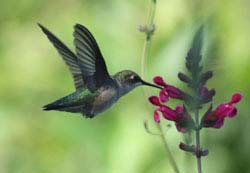Ten Favorite Flowers for Butterflies and Hummingbirds

Flowers that butterflies and hummingbirds favor are rich sources of nectar. But not all nectar-rich butterfly favorites are easy to access with long hummingbird beaks. Conversely, many flowers designed by nature to attract hummingbirds don't have the structure necessary for feeding butterflies or providing a perch. Butterflies need to alight and stand still on flowers from which they drink, whereas hummingbirds — similar to helicopters — are magnificent at hovering and can pause without support to take long sips.
When backyard space is limited, it can be daunting to design wildlife habitat that will attract butterflies and hummingbirds. So we've explored our catalog to provide you with planting choices that appeal to both.
Nectar Plants for Butterflies and Hummingbirds
Butterflies and hummingbirds access nectar from a wide variety of tube-shaped flowers. Although butterflies are attracted to blossoms from around the world, hummingbirds are pickier. They are only found in the Western Hemisphere and tend to prefer flowers from their half of the world. Agastaches, Cupheas, and Salvias are Western Hemisphere species that are favorites of each kind of tiny garden visitor.
Morello Anise Hyssop (Agastache ''Morello') Zones 5 to 11
- Burgundy-rose flowers bloom spring to fall
- 33 inches tall and 22 inches wide in bloom
- Fragrant, deep green foliage
- Full sun
- Heat and drought tolerant
Firecracker Plant (Cuphea ignea) Zones 8 to 11
- Hot orange flowers bloom summer to fall
- 24 inches tall and wide in bloom
- Rugged, deep green foliage
- Full sun to partial shade
- FBTS variety identical to Proven Winners® variety sold as Vermillionaire®
Wendy's Wish Sage (Salvia x ''Wendy's Wish') Zones 9 to 11
- Hot pink flowers bloom spring to fall
- 48 inches tall and 36 inches wide in bloom
- Foliage features dark maroon stems and pinkish-brown calyxes
- Full sun to partial shade
- Average to ample water
Elk Sonoran Red Pineapple Sage (Salvia elegans 'Elk Sonoran Red') Zones 9 to 11
- Deep red flowers bloom early in fall
- 24 inches tall and wide in bloom
- Mid-green, culinary foliage with pineapple fragrance
- Full sun
- Heat tolerant
Big Pitcher Sage (Salvia pitcheri 'Grandiflora') Zones 4 to 9
- Bicolor deep violet and light blue-to-white flowers bloom in fall
- 60 inches tall and 24 inches wide in bloom
- Bright green foliage, shaped like grass blades, and dusky purple calyxes
- Full sun to partial shade
- Heat and drought tolerant
VIBE Ignition White Sage (Salvia VIBE 'Ignition White') Zones 7 to 9
- Pure white flowers bloom spring to fall
- 30 inches tall and 24 inches wide in bloom
- Small, mid-green foliage
- Full sun to partial shade
- Heat and drought tolerant
- Formerly sold as Salvia x 'Elk White Ice'
Pink Mexican Bush Sage (Salvia leucantha 'Danielle's Dream') Zones 8 to 11
- Soft pink flowers bloom summer to fall
- 48 inches tall and 36 inches wide in bloom
- Velvety white bracts and stems, gray-green leaves
- Full sun
- Heat and drought tolerant
Waverly Sage (Salvia x 'Waverly') Zones 8 to 11
- White flowers bloom summer to winter
- 48 to 60 inches tall, 72 inches wide
- Dark green foliage and purplish-pink bracts
- Full sun
- Heat and drought tolerant
Pink Beach Autumn Sage (Salvia greggii 'Playa Rosa') Zones 7 to 9
- Two-tone pink flowers bloom spring to fall
- 24 inches tall and wide in bloom
- Fragrant, mid-green foliage with small, smooth leaves
- Full sun to partial shade
- Heat and drought tolerant
Rhythm and Blues Anise-Scented Sage (Salvia BODACIOUS 'Rhythm and Blues') Zones 7 to 10
- Deep violet-blue flowers bloom spring to fall
- 48 inches tall and 36 inches wide in bloom
- Foliage features deep green leaves and dark, almost black stems and calyxes
- Full sun to partial shade
- Average to ample water
- Stronger and longer blooming than Black & Blue Anise-Scented Sage
Buzzing with Questions?
At FBTS, we know a lot about about plants that butterflies, hummingbirds, and bees enjoy. We're also deeply aware of how important these small wildlife are to gardens. If you have questions about flowers in our catalog for wildlife gardening, we're glad to answer them. So, please contact us. Remember that when you grow wildlife habitat, you aid everyone's gardens in your neighborhood as well as hard-working pollinators.
Photo credit: Donna DeSousa

 Salvia x 'Waverly'
Salvia x 'Waverly'  Salvia pitcheri grandiflora
Salvia pitcheri grandiflora  Salvia leucantha 'Danielle's Dream'
Salvia leucantha 'Danielle's Dream'  Salvia x 'Wendy's Wish'
Salvia x 'Wendy's Wish'  Salvia greggii 'Playa Rosa'
Salvia greggii 'Playa Rosa'  Salvia BODACIOUS 'Rhythm and Blues'
Salvia BODACIOUS 'Rhythm and Blues'  Salvia VIBE® 'Ignition White'
Salvia VIBE® 'Ignition White'  Salvia elegans 'Elk Sonoran Red'
Salvia elegans 'Elk Sonoran Red'
Comments
There are no comments yet.